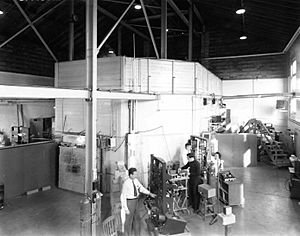Chicago Pile-3 facts for kids
Chicago Pile-3 (or CP-3) was a very important nuclear reactor. It was the world's first reactor to use something called heavy water. This special reactor was built in 1943 near Palos Hills, Illinois. It was part of the original site for Argonne National Laboratory.
CP-3 was one of the first research reactors. These are reactors built to study how nuclear reactions work. It started working on May 15, 1944. At first, it helped with scientific work for the Manhattan Project. This was a secret project during World War II to develop nuclear technology. CP-3 was used for research until 1954.
Contents
What Was Chicago Pile-3?
CP-3 was a special kind of nuclear reactor. It used natural uranium as its fuel. It also used heavy water to help control the nuclear reaction. Heavy water is like regular water but with a heavier type of hydrogen. It helped slow down tiny particles called neutrons. This slowing down is important for the reactor to work.
Why Was CP-3 Rebuilt?
In January 1950, CP-3 was taken apart. Scientists thought that the aluminum around the control rods might be rusting. Control rods help stop or start the nuclear reaction. If they were damaged, it could be a problem.
The reactor was rebuilt and given a new name: CP-3′ (pronounced "CP-3 prime"). It started working again in May 1950. This new version operated until 1954. CP-3 and CP-3′ were used for many studies.
What Did CP-3 Study?
Scientists used CP-3 to learn more about physics. They also studied how to separate different materials created by nuclear reactions. These are called fission products. Another task was to get a special material called tritium from irradiated lithium. Tritium is used in some nuclear technologies. Scientists even used the reactor to study how radioactive materials moved in animals. This helped them understand how these materials affect living things.
What Happened to CP-3?
After CP-3 was no longer needed, it was shut down. This process is called decommissioning. The fuel and heavy water were sent to another laboratory. This was the Oak Ridge National Laboratory.
The parts of the reactor, like pipes and valves, were placed inside its protective shell. This shell was then filled with concrete. The entire concrete-filled shell weighed about 800 short tons. It was buried in a 40-foot deep pit at the site.
Where Is the Site Today?
The place where CP-3 was buried is now known as the Site A/Plot M Disposal Site. It is located within Red Gate Woods. This area is part of the Cook County Forest Preserve system. A special marker is there today. It tells the story of CP-3 and another reactor, CP-1/CP-2, that was also at the site.


